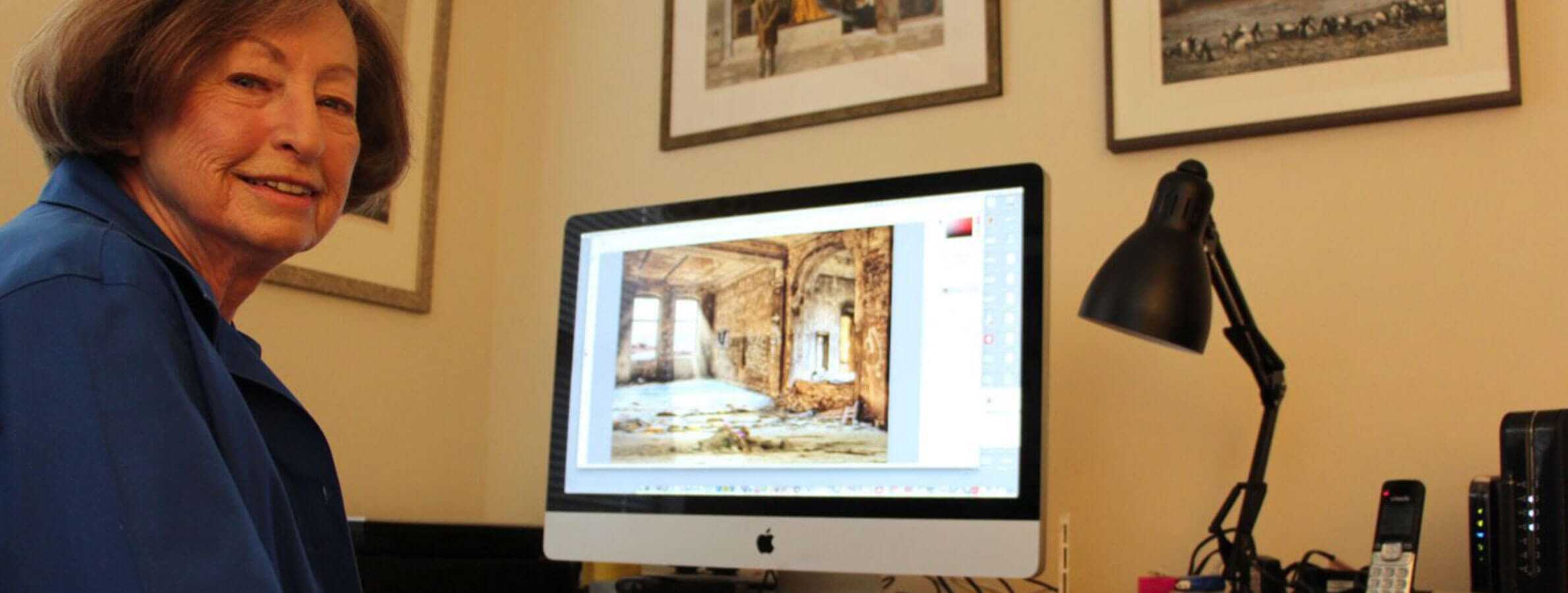Her work will immediately catch your eye. At first, you will think you are simply looking at a remarkable vantage point that was captured in one singular moment in time. Before long, you will start to wonder about the details. What would bring a flock of Adelie Penguins from Antarctica inside the walls of a seemingly abandoned brick building? How could such a neglected, graffiti-filled bedroom be in such close proximity of a beautiful, palatial home? The questions come, and still, your eyes want to believe.
Roslyn Rose’s recent work has a way of bending reality. “I look for buildings that have windows and doors that I can open up,” Roslyn explains. The finished piece is an integrated work that matches up different locations, often from different time periods. How she is able to create these unique viewpoints is a case study that illustrates why artists should never stop evolving.
“I had a very good traditional training as a painter with oils in the old Renaissance way of painting,” Roslyn recalls from the apartment she shares with her husband Frank at St. John’s Meadows. She transitioned from painting to printmaking and etching while in high school and then continued her art education at the Manhattan branch of the Pratt Institute. In the years that followed her formal training, Roslyn’s work appeared in galleries and shows throughout the New York Metropolitan area.
As audiences were exposed to her prints, she connected with print distributors and made a living as a working artist. Though the quality of her work created a demand for pieces from commercial decorators searching for art to adorn the walls of hotels, Roslyn laughs when she remembers what a judge at the first art show she entered gave as the secret to making a living as an artist. “He said that the difference between a professional artist and an amateur one is that the professional artist has a working spouse.” Frank’s work as an engineer and later as an Associate Professor at a community college he helped open in New Jersey was indeed conducive to keeping Roslyn’s professional focus on her artwork. Because Frank was able to take summers off, he and Roslyn were able to travel extensively. The photos Roslyn took during these trips to places like Spain, Germany, and Italy would become the focal point of her later work.
In the mid-1980s, Roslyn and Frank made the move from Maplewood—a suburban part of New Jersey—to the city of Hoboken. This one square mile large city directly across the Hudson River from midtown Manhattan became the backdrop for a major shift in Roslyn’s work. “When we moved to Hoboken, we came at the right time when everything was coming down and changing. At that point, artists were being invited in and encouraged to set up studios.”
During her time in Hoboken, Roslyn helped start a cooperative gallery called hob’art. Through her networking with other artists, she started speaking with some young photographers in town. “I was doing some collage work, and they suggested I start using Photoshop.” Roslyn was 72 years old in the winter of 2001 and she did not even own a computer. Despite her unfamiliarity with this technology, Roslyn credits her “young guru” who was able to get her up and running. This exposure to working digitally brought endless possibilities to the work she would be able to produce later in life. A quick view of her artist’s resume shows that a large percentage of her critical success from gallery exhibitions and accolades have occurred following her transition to working digitally.
Today, Roslyn’s home studio is equipped with an Apple iMac desktop computer, widescreen monitor, hi-resolution scanner, and graphics tablet. At 87, Roslyn finds that using this technology to create photographic montages is much easier than cutting photographs with tiny scissors and knives. “Digital technology allows more flexibility, such as the ability to make changes in color, placement, and design,” she points out. “There are many fascinating adjustments one can make to an image that were so hit and miss in the darkroom.”
In September, 2015 Roslyn and Frank moved from New Jersey to Rochester to be closer to Roslyn’s sister Peg—also a resident at St. John’s Meadows. While she has not been able to produce a lot of new works since her move, Roslyn was quick to establish roots here in the Rochester art community. “The artists in Rochester are very helpful and very friendly,” she says. She has secured studio space at the Anderson Alley Artists Studios and regularly participates in “First Friday” events. Six of Roslyn’s pieces will also appear in a group show at the Image City Gallery this October.
With the help of her nephew, Roslyn now has plans to spend some time photographing sights across Rochester to incorporate into future montages. While she plans to capture some of the many area nautical scenes, do not be surprised if you see Roslyn shooting some local examples of the abandoned buildings that have been featured in her previous work. “I like old buildings, but if I can get into old buildings that are falling apart I like that even better.”
To see examples of Roslyn’s stunning work and read her blog, visit RoslynRose.com

